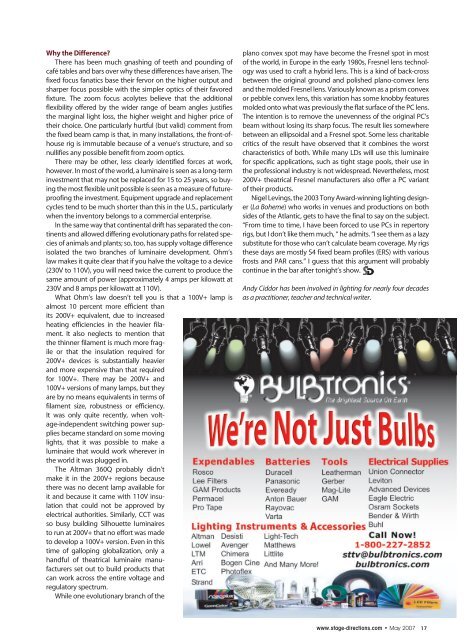May Issue - Stage Directions Magazine
May Issue - Stage Directions Magazine
May Issue - Stage Directions Magazine
You also want an ePaper? Increase the reach of your titles
YUMPU automatically turns print PDFs into web optimized ePapers that Google loves.
Why the Difference?<br />
There has been much gnashing of teeth and pounding of<br />
café tables and bars over why these differences have arisen. The<br />
fixed focus fanatics base their fervor on the higher output and<br />
sharper focus possible with the simpler optics of their favored<br />
fixture. The zoom focus acolytes believe that the additional<br />
flexibility offered by the wider range of beam angles justifies<br />
the marginal light loss, the higher weight and higher price of<br />
their choice. One particularly hurtful (but valid) comment from<br />
the fixed beam camp is that, in many installations, the front-ofhouse<br />
rig is immutable because of a venue’s structure, and so<br />
nullifies any possible benefit from zoom optics.<br />
There may be other, less clearly identified forces at work,<br />
however. In most of the world, a luminaire is seen as a long-term<br />
investment that may not be replaced for 15 to 25 years, so buying<br />
the most flexible unit possible is seen as a measure of futureproofing<br />
the investment. Equipment upgrade and replacement<br />
cycles tend to be much shorter than this in the U.S., particularly<br />
when the inventory belongs to a commercial enterprise.<br />
In the same way that continental drift has separated the continents<br />
and allowed differing evolutionary paths for related species<br />
of animals and plants; so, too, has supply voltage difference<br />
isolated the two branches of luminaire development. Ohm’s<br />
law makes it quite clear that if you halve the voltage to a device<br />
(230V to 110V), you will need twice the current to produce the<br />
same amount of power (approximately 4 amps per kilowatt at<br />
230V and 8 amps per kilowatt at 110V).<br />
What Ohm’s law doesn’t tell you is that a 100V+ lamp is<br />
almost 10 percent more efficient than<br />
its 200V+ equivalent, due to increased<br />
heating efficiencies in the heavier filament.<br />
It also neglects to mention that<br />
the thinner filament is much more fragile<br />
or that the insulation required for<br />
200V+ devices is substantially heavier<br />
and more expensive than that required<br />
for 100V+. There may be 200V+ and<br />
100V+ versions of many lamps, but they<br />
are by no means equivalents in terms of<br />
filament size, robustness or efficiency.<br />
It was only quite recently, when voltage-independent<br />
switching power supplies<br />
became standard on some moving<br />
lights, that it was possible to make a<br />
luminaire that would work wherever in<br />
the world it was plugged in.<br />
The Altman 360Q probably didn’t<br />
make it in the 200V+ regions because<br />
there was no decent lamp available for<br />
it and because it came with 110V insulation<br />
that could not be approved by<br />
electrical authorities. Similarly, CCT was<br />
so busy building Silhouette luminaires<br />
to run at 200V+ that no effort was made<br />
to develop a 100V+ version. Even in this<br />
time of galloping globalization, only a<br />
handful of theatrical luminaire manufacturers<br />
set out to build products that<br />
can work across the entire voltage and<br />
regulatory spectrum.<br />
While one evolutionary branch of the<br />
plano convex spot may have become the Fresnel spot in most<br />
of the world, in Europe in the early 1980s, Fresnel lens technology<br />
was used to craft a hybrid lens. This is a kind of back-cross<br />
between the original ground and polished plano-convex lens<br />
and the molded Fresnel lens. Variously known as a prism convex<br />
or pebble convex lens, this variation has some knobby features<br />
molded onto what was previously the flat surface of the PC lens.<br />
The intention is to remove the unevenness of the original PC’s<br />
beam without losing its sharp focus. The result lies somewhere<br />
between an ellipsoidal and a Fresnel spot. Some less charitable<br />
critics of the result have observed that it combines the worst<br />
characteristics of both. While many LDs will use this luminaire<br />
for specific applications, such as tight stage pools, their use in<br />
the professional industry is not widespread. Nevertheless, most<br />
200V+ theatrical Fresnel manufacturers also offer a PC variant<br />
of their products.<br />
Nigel Levings, the 2003 Tony Award-winning lighting designer<br />
(La Boheme) who works in venues and productions on both<br />
sides of the Atlantic, gets to have the final to say on the subject.<br />
“From time to time, I have been forced to use PCs in repertory<br />
rigs, but I don’t like them much, “ he admits. “I see them as a lazy<br />
substitute for those who can’t calculate beam coverage. My rigs<br />
these days are mostly S4 fixed beam profiles (ERS) with various<br />
frosts and PAR cans.” I guess that this argument will probably<br />
continue in the bar after tonight’s show.<br />
Andy Ciddor has been involved in lighting for nearly four decades<br />
as a practitioner, teacher and technical writer.<br />
www.stage-directions.com • <strong>May</strong> 2007 17

















